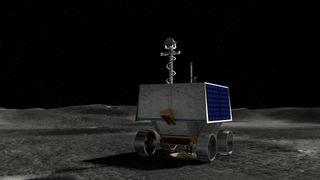NASA delays ice-hunting VIPER moon rover launch to 2024, a one-year slip
The one-year delay to November 2024 is needed for more und testing of commercial moon lander that will carry it.

NASA's new VIPER lunar rover must wait at least an extra year to search for ice on the surface of the moon.
The VIPER moon rover will now launch no earlier than 2024 following a NASA request for more ground testing of the Griffin lunar lander. Both Griffin and VIPER are made by the company Astrobotic.
The ice-hunting VIPER rover, the name is short for Volatiles Investigating Polar Exploration Rover, was supposed to touch down in November 2023 in the lunar south polar region to assess how much water might be available for human missions. NASA, however, asked for more time to assess Griffin's readiness for its debut mission, pushing the landing to November 2024.
"The additional tests aim to reduce the overall risk to VIPER's delivery to the moon," NASA said of the decision in a release Monday (July 18), but provided no other details. Astrobotic made no comment on social media or in a news release.
The Commercial Lunar Payload Services (CLPS) contract for Astrobotic will be allocated an additional $67.8 million to fulfill the extra work, bringing the total cost to $320.4 million, NASA stated.
Related: Moon VIPER: NASA to send a water-sniffing rover to lunar south pole
To allow for additional testing of the lunar lander that will deliver our VIPER rover to the lunar South Pole, its arrival to the Moon is now scheduled for 2024. More details: https://t.co/yvIWPCrv9s pic.twitter.com/rd3Ufk7S3oJuly 18, 2022
VIPER and other CLPS missions like it are meant to test technology and to scout for resources on the moon before humans get there. NASA is now aiming for 2025 for the first touchdown of its Artemis lunar program, pending the success of predecessor missions. Artemis 1 is expected to do an uncrewed round-the-moon test later this year, at the earliest.
Get the Space.com Newsletter
Breaking space news, the latest updates on rocket launches, skywatching events and more!
VIPER's mission was initially contracted in 2020 with a maximum value of $199.5 million, which was meant as a fixed-cost fee covering every aspect of launch and landing, NASA said at the time. Astrobotic subsequently selected SpaceX to launch the rover under a competitive procurement, choosing the Falcon Heavy rocket most famous for sending the "Starman" mannequin to space in 2018. NASA and Astrobotic had initially aimed to launch VIPER to the moon in December 2022, but delayed it to 2023 to allow time for upgrades to the rover to extend its life and science abilities.
Astrobotic has another CLPS mission to deliver a smaller lander, called Peregrine, to the moon no earlier than 2022. The Pennsylvania-based company announced Friday (July 15) on Twitter that Peregrine's collection of 24 small science payloads are successfully integrated with the lander's flight decks.
Follow Elizabeth Howell on Twitter @howellspace. Follow us on Twitter @Spacedotcom and on Facebook.
Join our Space Forums to keep talking space on the latest missions, night sky and more! And if you have a news tip, correction or comment, let us know at: community@space.com.

Elizabeth Howell (she/her), Ph.D., is a staff writer in the spaceflight channel since 2022 covering diversity, education and gaming as well. She was contributing writer for Space.com for 10 years before joining full-time. Elizabeth's reporting includes multiple exclusives with the White House and Office of the Vice-President of the United States, an exclusive conversation with aspiring space tourist (and NSYNC bassist) Lance Bass, speaking several times with the International Space Station, witnessing five human spaceflight launches on two continents, flying parabolic, working inside a spacesuit, and participating in a simulated Mars mission. Her latest book, "Why Am I Taller?", is co-written with astronaut Dave Williams. Elizabeth holds a Ph.D. and M.Sc. in Space Studies from the University of North Dakota, a Bachelor of Journalism from Canada's Carleton University and a Bachelor of History from Canada's Athabasca University. Elizabeth is also a post-secondary instructor in communications and science at several institutions since 2015; her experience includes developing and teaching an astronomy course at Canada's Algonquin College (with Indigenous content as well) to more than 1,000 students since 2020. Elizabeth first got interested in space after watching the movie Apollo 13 in 1996, and still wants to be an astronaut someday. Mastodon: https://qoto.org/@howellspace
